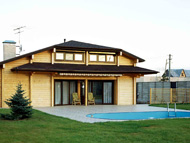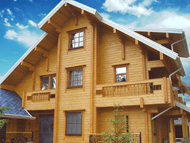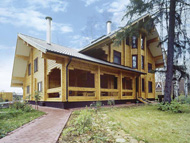House Standards
Modular Glulam Beam Technology House Standards
The basic construction element is a glued laminated (glulam) beam, which is available in three sizes: 212x186 mm, 169x186 mm, and 126x186 mm. The laminas used for the manufacture of glulam beams are made of fir from the northern regions of Russia. The laminas are glued together using environmentally friendly Casco Adhesives produced by AkzoNobel (Sweden).
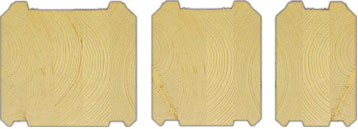
Naturally, the time necessary for the own construction is considerably shorter. For example, the speed of construction with the use of the Canadian technology is approx. 1.5 m3 per shift compared to 3.5 m3 when applying the glulam beam technology.
This means that four people may build a house with an area of 200 m2 in just 20 days!
Rough Structure
When the construction of a rough structure is ordered, the price of which starts at CZK 16,000 per square metre (depending on the complexity of the project), we secure the manufacture of the wooden structure, interior partition walls and the roof construction, transport to the construction site, assembly, preparatory works for sanitary and technical installations and mains, as well as joint insulation. The price of turnkey log houses starts at CZK 32,000 per square metre.
Foundation Slab Construction
B20 - B25 concrete is used for the casting of the foundation slab. Welded reinforcement mesh is used as bottom and top armature. STYRODUR insulation boards are standardly placed under the top reinforcement layer as integrated thermal insulation. When the casting of the foundation slab is finished, a technological interruption is necessary to allow the concrete to harden (usually 28 days). After hardening, the foundation slab is covered with ROOFTEK PRO ALU MINERAL anti-radon insulation and Glastek 40 Mineral hydro-insulation layers.
Standard foundation slab construction works also include a survey aimed at detecting pathogenic zones and radon measurements.
Interior Walls
he interior non-bearing walls of the log house, i.e. partition walls, are erected according to the client's requirements. ISOLENA sheep wool is used as thermal and noise insulation, which helps maintain a pleasant climate inside the house thanks to its excellent properties and is also anti allergic.
Wood Types
We largely use spruce and fir laminas for the production of glulam beams since these tree species offer a high quality structure with minimum knots.
Wood Protection
We use a variety of KREIDEZEIT preservative coating and care products to protect the wooden components of our structures. These include natural oils and waxes that provide both surface and in-depth protection. All wooden components are first impregnated with Bochemit boron salt. The base oil coat is then applied and finally, the top pigmented oil coat is applied which also provides UV protection. Kreidezeit base oil is mainly made with the use of flax seed varnish and balsamic turpentine oil. The final topcoat oil is mixed with colorants for which we use only high quality baked earth and mineral pigments. After 7 years, the wooden structure is finally impregnated by applying another top layer with pigments whereby the shell of the log house is permanently protected. In case of pure wood flooring, we use hard floor oil. It penetrates well into the base material, protects the wood against dirt and dampness, and it offers high mechanical resistance. Interior and exterior walls are impregnated with natural oils. There are several types of natural oils for interior and exterior use. When used in the interior, natural oils are complemented with natural wax. In case of your interest, KREIDEZEIT offers a wide pallet of pigmented glazes that may be combined to achieve the desired shade of your family home. We standardly use the Red Pine, which is an ideal shade for pinewood.
Wall Insulation
The most suitable thermal insulation for log houses is ISOLENA, which is made of sheep wool. It is installed in a thin layer between the individual wall components. This natural and ecological material made of treated sheep wool offers outstanding thermal and insulation properties and it is anti allergic. As it contains protein fibres, it is safe for human health and it is not necessary to wear a respirator when working with this insulation material.
Advantages of ISOLENA
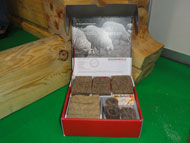 As regards various natural materials, sheep wool definitely deserves special attention. Compared to other fibre materials, it is easy to handle. Wool is genuinely flexible and it expands to its original size after being pressed, which makes it ideal for sealing even very irregular openings. In a multi-layer insulation system, wool may be also used to regulate the level of humidity in the interior. Nevertheless, the primary advantage of wool is that it is the only material the production of which is friendly to the environment and has no negative impacts.
As regards various natural materials, sheep wool definitely deserves special attention. Compared to other fibre materials, it is easy to handle. Wool is genuinely flexible and it expands to its original size after being pressed, which makes it ideal for sealing even very irregular openings. In a multi-layer insulation system, wool may be also used to regulate the level of humidity in the interior. Nevertheless, the primary advantage of wool is that it is the only material the production of which is friendly to the environment and has no negative impacts.
Installation
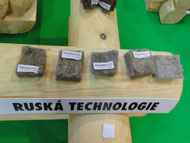 Sheep wool applied in an even layer is ideal for insulating large surfaces. Instead of a single thick layer, it may be applied in multiple layers, e.g. if one layer is 4 cm thick, three double layers may be added from the outside and thus, the total thickness may reach up to 25 cm. Clippings or leftovers from production may be used for sealing small crevices and hollow spaces.
Sheep wool applied in an even layer is ideal for insulating large surfaces. Instead of a single thick layer, it may be applied in multiple layers, e.g. if one layer is 4 cm thick, three double layers may be added from the outside and thus, the total thickness may reach up to 25 cm. Clippings or leftovers from production may be used for sealing small crevices and hollow spaces.
Pest Protection
In order to protect wool against pests, its fibres are treated with a synthetic analogue of a naturally occurring insecticide (i.e. pyrethroid), which prevents moth infestation. Pyrethroid remains permanently on the fibre surface without penetrating into the surrounding environment. Objections claiming that wool may be eaten by mice are unsubstantiated as rodents are unable to feed on wool or other insulation materials.
Flammability
Wool is the least flammable of all currently used organic insulation materials. For reduced flammability, wool fibres may be treated with such retardants as ammonium phosphate.
Improperly Installed Insulation
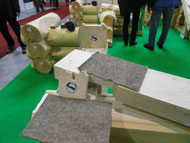 When exposed to moisture, some organic materials may be infested by fungi. It should be noted that no construction insulation material (unless designated for underwater insulation) should be exposed to moisture. Admitting such possibility would be the same as accepting lousy construction work. If, nonetheless, moisture from the heated interiors penetrates into the insulation as a result of a gross technological error, wool presents a major advantage: almost one third of the fibre mass may comprise the absorbed moisture and only after this volume is exceeded, water will begin to condensate on the surface of the fibres and aggravate their insulation properties. In this sense, sheep wool is a fibre material, which is extremely resistant to construction errors. Therefore, the warm section of the insulation in front of the moisture stop is able to effectively regulate air humidity in the interior.
When exposed to moisture, some organic materials may be infested by fungi. It should be noted that no construction insulation material (unless designated for underwater insulation) should be exposed to moisture. Admitting such possibility would be the same as accepting lousy construction work. If, nonetheless, moisture from the heated interiors penetrates into the insulation as a result of a gross technological error, wool presents a major advantage: almost one third of the fibre mass may comprise the absorbed moisture and only after this volume is exceeded, water will begin to condensate on the surface of the fibres and aggravate their insulation properties. In this sense, sheep wool is a fibre material, which is extremely resistant to construction errors. Therefore, the warm section of the insulation in front of the moisture stop is able to effectively regulate air humidity in the interior.
Log House Roof Construction
House without 2nd Floor
Roofing – BETA concrete roofing tiles in the basic price range with accessories for valleys, hips, ridges, and ventilation elements. Other accessories are not included in the price. Counter and lateral lathing, Jutafol roof foil for diffusion roof underlay.
Windows, winter gardens and balcony doors
Wood euro windows, length-linked prisms in northern pine, with triple transparent glass, without grids, four-sided fittings - Geus Benešov
Velux GGL roof windows
External window sills – galvanized iron or Lindab - Geus Benešov
Internal window sills – wood/plastic - Geus Benešov
Window roller and slat blinds are not included in the price
Main entrance door and garage door - Geus Benešov, LOMAX
Interior doors - Geus
Main entrance and interior doors - Geus
Interior doors – Aldi
Flooring
First floor: 180 mm - dry Rigidur flooring system, 2x60 mm Styrodur board thermal insulation, floor heating system (NOBO heating cables) or water heating, 10 mm floor covering.
Second floor: 35 mm board ceiling, 200 mm Orsil insulation (2x10 mm crosswise hardboard), 20 mm Rigidur gypsum-fibre board.
Third floor: the attic board ceiling is not included in the price.
Floors - Aldi
Rainwater Pipes
The roof gutters and rainwater pipes are made of galvanized iron or copper (Lindab). The delivery does not include connections to the storm sewer system.
Wall and Floor Tiling
Ceramic wall and floor tiling at the price of CZK 300/m2 without accessory material. Floor tiles – entrance hallway, bathroom and toilet on the first and second floor. Wall tiles – bathroom and toilet on the first and second floor up to the height of 2 metres (straight tiling).
Sanitary Ceramics
White with plastic piping
Grey PVC sewer mains
Electrical Wiring
Copper (CU) wiring, selection of distribution box according to the specific house type, double-frame and fire-resistant electrical box, universal white Tango colour, white switches and electrical sockets. Basic equipment varies depending on the individual house type.
Heating
The house is heated by means of a Hotjet air-to-water heat pump with a Siemens control unit in combination with an electric boiler and floor heating. Upon the client's request, standard panel radiators may be installed and/or the heating system may be replaced with an electrical heating system, a gas heating system or solar panel heating system. The price of the house does not include a fireplace.
We also offer a rainwater retention system, which allows further use of rainwater captured in an underground plastic or concrete tank.
In addition, other than standard construction materials, heating systems, fittings and equipment may be used according to the client's wishes.
All used construction materials have been duly certified in terms of quality and safety to health.

Naturally, the time necessary for the own construction is considerably shorter. For example, the speed of construction with the use of the Canadian technology is approx. 1.5 m3 per shift compared to 3.5 m3 when applying the glulam beam technology.
This means that four people may build a house with an area of 200 m2 in just 20 days!
Rough Structure
When the construction of a rough structure is ordered, the price of which starts at CZK 16,000 per square metre (depending on the complexity of the project), we secure the manufacture of the wooden structure, interior partition walls and the roof construction, transport to the construction site, assembly, preparatory works for sanitary and technical installations and mains, as well as joint insulation. The price of turnkey log houses starts at CZK 32,000 per square metre.
Foundation Slab Construction
B20 - B25 concrete is used for the casting of the foundation slab. Welded reinforcement mesh is used as bottom and top armature. STYRODUR insulation boards are standardly placed under the top reinforcement layer as integrated thermal insulation. When the casting of the foundation slab is finished, a technological interruption is necessary to allow the concrete to harden (usually 28 days). After hardening, the foundation slab is covered with ROOFTEK PRO ALU MINERAL anti-radon insulation and Glastek 40 Mineral hydro-insulation layers.
Standard foundation slab construction works also include a survey aimed at detecting pathogenic zones and radon measurements.
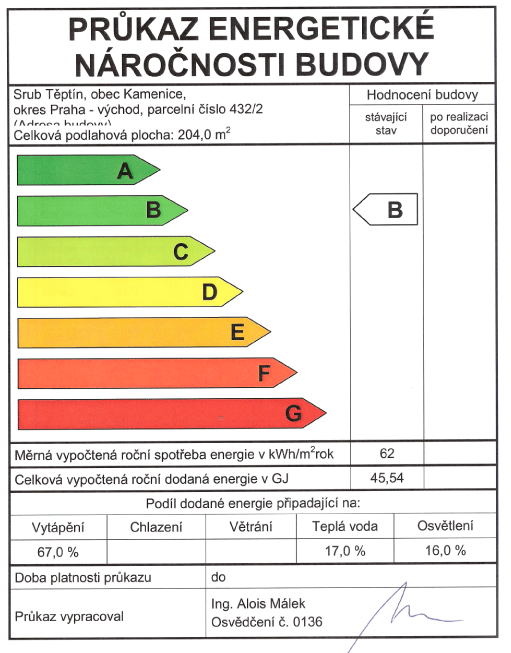 |
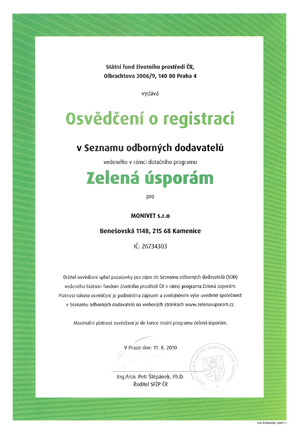 |
Interior Walls
he interior non-bearing walls of the log house, i.e. partition walls, are erected according to the client's requirements. ISOLENA sheep wool is used as thermal and noise insulation, which helps maintain a pleasant climate inside the house thanks to its excellent properties and is also anti allergic.
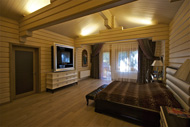 |
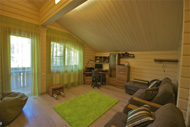 |
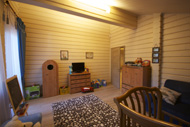 |
Wood Types
We largely use spruce and fir laminas for the production of glulam beams since these tree species offer a high quality structure with minimum knots.
Wood Protection
We use a variety of KREIDEZEIT preservative coating and care products to protect the wooden components of our structures. These include natural oils and waxes that provide both surface and in-depth protection. All wooden components are first impregnated with Bochemit boron salt. The base oil coat is then applied and finally, the top pigmented oil coat is applied which also provides UV protection. Kreidezeit base oil is mainly made with the use of flax seed varnish and balsamic turpentine oil. The final topcoat oil is mixed with colorants for which we use only high quality baked earth and mineral pigments. After 7 years, the wooden structure is finally impregnated by applying another top layer with pigments whereby the shell of the log house is permanently protected. In case of pure wood flooring, we use hard floor oil. It penetrates well into the base material, protects the wood against dirt and dampness, and it offers high mechanical resistance. Interior and exterior walls are impregnated with natural oils. There are several types of natural oils for interior and exterior use. When used in the interior, natural oils are complemented with natural wax. In case of your interest, KREIDEZEIT offers a wide pallet of pigmented glazes that may be combined to achieve the desired shade of your family home. We standardly use the Red Pine, which is an ideal shade for pinewood.
|
|
|
|
Wall Insulation
The most suitable thermal insulation for log houses is ISOLENA, which is made of sheep wool. It is installed in a thin layer between the individual wall components. This natural and ecological material made of treated sheep wool offers outstanding thermal and insulation properties and it is anti allergic. As it contains protein fibres, it is safe for human health and it is not necessary to wear a respirator when working with this insulation material.
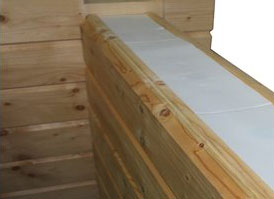 |
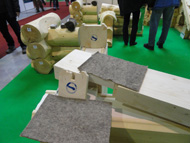 |
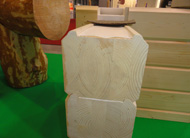 |
Advantages of ISOLENA
 As regards various natural materials, sheep wool definitely deserves special attention. Compared to other fibre materials, it is easy to handle. Wool is genuinely flexible and it expands to its original size after being pressed, which makes it ideal for sealing even very irregular openings. In a multi-layer insulation system, wool may be also used to regulate the level of humidity in the interior. Nevertheless, the primary advantage of wool is that it is the only material the production of which is friendly to the environment and has no negative impacts.
As regards various natural materials, sheep wool definitely deserves special attention. Compared to other fibre materials, it is easy to handle. Wool is genuinely flexible and it expands to its original size after being pressed, which makes it ideal for sealing even very irregular openings. In a multi-layer insulation system, wool may be also used to regulate the level of humidity in the interior. Nevertheless, the primary advantage of wool is that it is the only material the production of which is friendly to the environment and has no negative impacts. Installation
 Sheep wool applied in an even layer is ideal for insulating large surfaces. Instead of a single thick layer, it may be applied in multiple layers, e.g. if one layer is 4 cm thick, three double layers may be added from the outside and thus, the total thickness may reach up to 25 cm. Clippings or leftovers from production may be used for sealing small crevices and hollow spaces.
Sheep wool applied in an even layer is ideal for insulating large surfaces. Instead of a single thick layer, it may be applied in multiple layers, e.g. if one layer is 4 cm thick, three double layers may be added from the outside and thus, the total thickness may reach up to 25 cm. Clippings or leftovers from production may be used for sealing small crevices and hollow spaces.Pest Protection
In order to protect wool against pests, its fibres are treated with a synthetic analogue of a naturally occurring insecticide (i.e. pyrethroid), which prevents moth infestation. Pyrethroid remains permanently on the fibre surface without penetrating into the surrounding environment. Objections claiming that wool may be eaten by mice are unsubstantiated as rodents are unable to feed on wool or other insulation materials.
Flammability
Wool is the least flammable of all currently used organic insulation materials. For reduced flammability, wool fibres may be treated with such retardants as ammonium phosphate.
Improperly Installed Insulation
 When exposed to moisture, some organic materials may be infested by fungi. It should be noted that no construction insulation material (unless designated for underwater insulation) should be exposed to moisture. Admitting such possibility would be the same as accepting lousy construction work. If, nonetheless, moisture from the heated interiors penetrates into the insulation as a result of a gross technological error, wool presents a major advantage: almost one third of the fibre mass may comprise the absorbed moisture and only after this volume is exceeded, water will begin to condensate on the surface of the fibres and aggravate their insulation properties. In this sense, sheep wool is a fibre material, which is extremely resistant to construction errors. Therefore, the warm section of the insulation in front of the moisture stop is able to effectively regulate air humidity in the interior.
When exposed to moisture, some organic materials may be infested by fungi. It should be noted that no construction insulation material (unless designated for underwater insulation) should be exposed to moisture. Admitting such possibility would be the same as accepting lousy construction work. If, nonetheless, moisture from the heated interiors penetrates into the insulation as a result of a gross technological error, wool presents a major advantage: almost one third of the fibre mass may comprise the absorbed moisture and only after this volume is exceeded, water will begin to condensate on the surface of the fibres and aggravate their insulation properties. In this sense, sheep wool is a fibre material, which is extremely resistant to construction errors. Therefore, the warm section of the insulation in front of the moisture stop is able to effectively regulate air humidity in the interior. Log House Roof Construction
House without 2nd Floor
Roofing – BETA concrete roofing tiles in the basic price range with accessories for valleys, hips, ridges, and ventilation elements. Other accessories are not included in the price. Counter and lateral lathing, Jutafol roof foil for diffusion roof underlay.
Windows, winter gardens and balcony doors
Wood euro windows, length-linked prisms in northern pine, with triple transparent glass, without grids, four-sided fittings - Geus Benešov
Velux GGL roof windows
External window sills – galvanized iron or Lindab - Geus Benešov
Internal window sills – wood/plastic - Geus Benešov
Window roller and slat blinds are not included in the price
Main entrance door and garage door - Geus Benešov, LOMAX
Interior doors - Geus
Main entrance and interior doors - Geus
Interior doors – Aldi
Flooring
First floor: 180 mm - dry Rigidur flooring system, 2x60 mm Styrodur board thermal insulation, floor heating system (NOBO heating cables) or water heating, 10 mm floor covering.
Second floor: 35 mm board ceiling, 200 mm Orsil insulation (2x10 mm crosswise hardboard), 20 mm Rigidur gypsum-fibre board.
Third floor: the attic board ceiling is not included in the price.
Floors - Aldi
Rainwater Pipes
The roof gutters and rainwater pipes are made of galvanized iron or copper (Lindab). The delivery does not include connections to the storm sewer system.
Wall and Floor Tiling
Ceramic wall and floor tiling at the price of CZK 300/m2 without accessory material. Floor tiles – entrance hallway, bathroom and toilet on the first and second floor. Wall tiles – bathroom and toilet on the first and second floor up to the height of 2 metres (straight tiling).
Sanitary Ceramics
White with plastic piping
Grey PVC sewer mains
Electrical Wiring
Copper (CU) wiring, selection of distribution box according to the specific house type, double-frame and fire-resistant electrical box, universal white Tango colour, white switches and electrical sockets. Basic equipment varies depending on the individual house type.
Heating
The house is heated by means of a Hotjet air-to-water heat pump with a Siemens control unit in combination with an electric boiler and floor heating. Upon the client's request, standard panel radiators may be installed and/or the heating system may be replaced with an electrical heating system, a gas heating system or solar panel heating system. The price of the house does not include a fireplace.
We also offer a rainwater retention system, which allows further use of rainwater captured in an underground plastic or concrete tank.
In addition, other than standard construction materials, heating systems, fittings and equipment may be used according to the client's wishes.
All used construction materials have been duly certified in terms of quality and safety to health.
